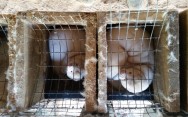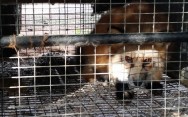Blog Archives
Home -
Archive by category "News"
On December 2, 2025, Mexico made a historic leap forward for animal rights by amending its
Constitution to include protections for nonhuman animals. This reform is the first of its kind in the
nation. While many countries have animal protection laws, few have elevated the protection of
animals to constitutional status, and even fewer have extended this to cover all species, including
farmed animals. Mexico’s new constitutional changes mark a groundbreaking shift towards treating
animals as beings deserving of legal recognition and rights, regardless of their species.
In most countries, animal welfare laws are selective, often prioritizing companion animals over those
in agricultural industries. In the United States, for example, farmed animals are often excluded from
protections that apply to pets or wildlife. Mexico’s reforms aim to change that by ensuring all
animals, from farmed animals to those kept as pets, are entitled to legal protection. This
approach could set an example for other nations, particularly in Latin America, where animal rights
movements are gaining momentum. However, with Mexico being one of the world’s top producers
of meat and animal products, it is highly probably that economic interests will hinder the
implementation of these reforms. Agricultural lobbyists could easily push back against these laws to try to
protect profits.
One particularly important aspect of the reforms that could have a positive impact on the future is
education. The changes require the inclusion of animal welfare education in Mexican schools. In the
best-case scenario this could influence a new generation that values and understands animal rights.
It could be the first step in changing cultural attitudes towards animals on a larger scale. While the
specific details of this educational shift have yet to be defined, the hope is that it will lead to a
transformation in how Mexican society views and treats animals in the future.
The constitutional amendment represents a step forward in recognizing animals as sentient beings
with rights, but the true test will be in the details. It is unlikely that Mexico will go far enough in
creating strong, enforceable laws that truly afford equal protection to animals. On the other hand,
this victory sends a message about the direction society is capable of going if social imagination can
conceive of animals as equal beings to humans. There are many self-interested forces at work trying
to convince humans that it is too difficult to value animals in parity to ourselves, that there are too
many problems or steps to be taken, and true equality for animals is not possible. Legislation at a
constitutional level proves that changes can be far-reaching and can affect all animals.
At Freedom 4 Animals, our work includes both education and advocacy. Both of these things
contribute to change, as people learn about our fellow inhabitants of this earth and how we can
elevate their status as beings worthy of equal consideration. Please read more about our work to
educate the public and fight for animal freedom.
A campaign is underway to get Congress to pass the SAFE Act, which has been stalled in congress since last year. Click on the link to sign the petition to stop horses being exported abroad for slaughter:
The US has banned the slaughter of horses at home. However, this ban means nothing while it’s still legal to transport horses thousands of miles to be slaughtered in the horsemeat trade, their last moments spent in the “kill box,” frightened and panicked before being chopped to bits. Wild horse slaughter in the U.S. was shut down in 2007 but the export industry still sends 20,000 horses every year to their deaths in Canada and Mexico. Not only this but the horses first endure long, gruelling journeys in cramped and cruel conditions before they are killed. According to a 2023 report from the American Journal of Veterinary Research, the horse export industry thrives and generates around $500 million a year,
With all the panic surrounding unverified claims that cats and dogs are being eaten in the United States, it’s a good time to draw attention to the plight of horses. The SAFE Act, or Save America’s Forgotten Equines Act (HR 3475/S 2037) is a bill that animal activists have been pushing to get passed for decades. In its current form the SAFE Act amends the 2018 Dog and Cat Meat Trade Prohibition Act to add equines to the list of animals prohibited to be exported slaughter.
Polls show that 83% of Americans oppose horse slaughter. Yet thousands of horses each year face a horrible ending to their lives. The meat industry lobbies to protect the export of horse slaughter by claiming that if horses are not slaughtered, there will be more neglect and nowhere to rehome horses. Contrary to these claims, the export of horses has actually decreased over the years and shelters are ready to rehome horses, the majority of whom can live out happy and productive lives.
Horses are incredibly sensitive animals who need freedom of movement and family bonds with their fellow horses. Capturing them and transporting them for 24 hours to be killed is not only murder, it is prolonged torture.
As well as a petition there is also a website that makes it easy for you to write to your member of congress to pressure them to sponsor and pass the SAFE Act.
At Freedom 4 Animals, we have done extensive work to preserve the right of free-roaming horses to remain with their families and negotiate and advocate to protect horses from mistreatment, neglect and cruelty, as well as education and working with policy-makers and NGOs on legislation and initiatives to support and protect the freedom of horses.
Please read more about the work we do on behalf of horses and other animals.
After Kristy Noem boasted about shooting her puppy in cold blood, now there are reports that right
wing figurehead Kevin Roberts told several people that he killed a neighbor’s dog with a shovel to
stop her from making noise.
The dog, Loca, disappeared in 2004, the year Roberts was alleged to have boasted about killing her.
It’s impossible to verify whether the story is true or not but there is evidence that casts suspicion on
Roberts.
The chair of the history department at New Mexico State University where Roberts worked recalled hearing the story, as did two other people, a professor andher spouse and three others who said they heard the account at the time from others. Roberts hadn’t said the dog was a danger, according to these reports, he had just said the dog was loud, and he appeared proud of what he had done.
Roberts named the neighbor who owned the dogs, Daniel Aran, and claimed that animal control had
come to rescue multiple dogs from the property, casting himself as a concerned neighbor, as well as
citing that Aran went to prison for cocaine distribution. Aran and his mother denied that animal
control had come to rescue any dogs. They both said they had a dog go missing around 2004, the
year when Roberts boasted about killing a dog. They spoke with affection about their dog, “my little
Loca.” Aran said Loca had been his favorite dog. “She was a little, little thing like this,” Aran said.
“She was a tiny, cute little thing.”
Aran said he and his mother went searching for the dog but could never find her, and dog catchers
weren’t able to find her either.
We will never know what happened to little Loca, or what she had to endure in her final moments.
Despite concerning evidence, this cold case will never go investigated and little Loca’s mystery will
not be solved. Any justice that may be due to her will not be served.
Although we have no way of knowing whether these allegations are true, it’s a chilling story that
should serve as a reminder that animals do not receive the same treatment in the criminal justice
system that humans do. Loca deserved better than this.
At Freedom 4 Animals we work with lawmakers, nonprofits, animal rights groups, and individuals to
seek justice for animals and their human custodians who have been harmed, and to advocate for
animal rights within the criminal justice system and beyond. We work to educate the public and
anyone who is interesting in learning about animal rights about the role of animals in society and
how we can re-address those roles to achieve freedom and equality for animals.
To learn more about how animals are treated differently in the criminal justice system and how
violence to animals predicts other forms of violence, please visit the resources on our website.
The Miami-Dade commission has served eviction papers to the Dolphin Company, the owners of the Miami Seaquarium, after the company presided over severe neglect and poor conditions for animals in their care for many years. The Miami-Dade commission has ordered the Dolphin Company to vacate the premises by the 21st of April 2024. The commission’s letter cited violations of the lease agreement which included “not just a default, but a complete disregard for the safety of the animals housed on the premises.”
The history of the park is one of sadness, neglect, cruelty and enslavement for animals. The park’s history as an amenity for humans on the other hand, is one in which it enriched a private company and in the park’s earlier years was the third largest contributor to Miami-Dade County’s revenue through lease and tax payments.
The park is behind at least $180,000 in rent, which is one reason for the Miami-Dade commission’s decision. The decision was also motivated by the park’s numerous USDA violations and the loss of its Humane Society of America certification. Animal rights organizations have spoken out against the facility for years, in some cases managing to rescue animals, such as a pair of manatees, Romeo and Juliet. At least 120 dolphins and whales have died in captivity at the park. A dolphin named Sundance recently died shortly after a USDA inspection, where it was noted that the dolphin had “signs of gastric distress.” Federal inspections showed that the park’s infrastructure was deteriorating. A dolphin was found with a two-inch nail in its throat. Another dolphin was found with a broken metal bolt in its mouth.
One of the park’s major problems was that it couldn’t keep staff. Multiple staff resigned at the conditions of the park, and some alleged retaliation when they tried to speak up against the conditions. Due to money problems and difficulty retaining staff, the park didn’t have enough veterinarians to attend to the animals. The veterinary lab lacked basic tools and the animals were denied surgery, including a sea lion with eye pain, who stopped eating. One of the park’s animals, an Orca named Tokitae, gained recognition for all the wrong reasons, because the tank she was forced to live in was the nation’s smallest tank. Since coming to the world’s attention, Toki, also known as Lolita, has died.
Why did it take so long for the neglect to be put to an end? There is a bureaucratic process that has to happen to hold such facilities accountable. The park was known to be an unhealthy and cruel place for animals to live for decades. Attention wasn’t focused on the park soon enough because parks like these were for many years deemed to be acceptable entertainment and education for humans. The roles of animals at these parks, who are forced to perform for humans, and who are kept in restrictive conditions and separate from family members, were not questioned. It’s now time to question the rationale for keeping animals in these facilities. There may be some conservation reasons for keeping some species of animals captive, but even then, keeping animals in captivity, where they can be exploited, should be viewed with public skepticism and treated as a last resort.
|
Tags: Animal Neglect,
animal rights,
Animals in Captivity,
Dolphin,
Kevin Boileau,
Marine Animals,
Marine Park,
Miami Seaquarium,
Nazarita Goldhammer,
Orca,
Toki the Orca,
Whale
South Korea’s dogmeat trade has long been a national source of shame, especially to younger
people, who have developed more progressive views about animals. Pets such as domestic dogs and
cats have become more popular, changing people’s views of dogs as disposable animals that can
be farmed for meat. The dogmeat trade has been dying out on its own, but it has lingered on. The
dog meat trade is incredibly cruel and dogs are often killed in extremely painful ways. Dogs are kept
caged and suffer cruel conditions where they see other dogs killed. As social animals, this must be
unbearable to them.
Last year, South Korea’s parliament voted near unanimously to ban the dog meat industry. The law
takes effect in 2027 and will ban any future slaughter breeding and sale of dogs for dog meat.
The consumption of dog meat is based on historical traditions and unscientific beliefs about the
health benefits of dog meat. One of the most horrifying things about these traditions is that dogs are
deliberately tortured before death because of the belief that the adrenaline levels in the animal will
contribute to health benefits. Although dog meat was traditionally eaten in South Korea in the past,
there is evidence that this was not widespread and it became more popular due to false beliefs
about its effects on virility in older men. Animals have long been tortured because of human crazes
and the dog meat industry is a particularly cruel example. Not only are animals farmed for dog meat
but also abandoned pets are collected from the streets and slaughtered for the dog meat trade.
Activists inside and outside of the countries where dog meat is eaten have protested the practice.
On the other hand, condemning the practice has been associated with anti-Asian racism in incidents
in the US where restaurants have been falsely accused of selling dog meat. Consuming dog meat is
not “barbaric” because of a country’s culture, it is barbaric because humans are capable of extreme
cruelty towards animals when it is in their own interests.
Although it’s positive that dogs will be protected from this horrific cruelty in the future, the dog
meat ban should not draw attention away from the suffering of all animals such as cows, which in
Western culture are slaughtered for meat while in Korean culture traditionally were not killed and
kept as work animals. Animal rights activists and philosophers have argued against “speciesism,” in
which some animals are considered more deserving of safety than others. Banning dog meat is a
reflection of the public’s increasing intolerance of cruelty toward animals that are kept as pets.
Ultimately we must fight for animal rights to be extended beyond pets and towards all animals.
|
Tags: Animal Breeding,
Animal Cruelty,
animal rights,
Animal Suffering,
Cruelty to Dogs,
Dogmeat Industry,
Kevin Boileau,
Nazarita Goldhammer,
Speciesism,
Transhumanism,
Vegan
Animal welfare services are investigating the Ontario marine park where 14 whales and 1 dolphin have died in the space of a few years. The park is a big employer in the area and it has denied any wrongdoing, including any water quality issues that could have led to deaths at the park.
The park has a vested interest in keeping animals in roles where they are visible to the public, and formerly held shows in which its animals performed tricks and members of the public could feed its animals.
During a 2 year period, 12 beluga whales died. At the same time, provincial authorities had raised concerns about the park’s water quality and had recognized that all of the marine mammals were in distress. There have been protests and demonstrations for many years against the treatment of animals in the park. Citations against the park have resulted in 5 counts of animal cruelty by the Ontario Society for the Prevention of Cruelty to Animals in 2016 and 6 counts of cruelty by the OSPCA in 2017.
The animals that died include a beluga whale named Ikora, who died on October 24th 2019 and 10 others including a beluga named Bull, who died on November 23, 2021. 3 more deaths were confirmed in 2023, including Kisko, who was called “the world’s loneliest whale.” She was the last killer whale in captivity in Canada, and was originally captured along with Keiko, the star of Free Willy. She endured loneliness throughout her life in captivity, as she was confined to a small tank without companions. She died at the age of 47. The other animals who died in 2023 were a dolphin and a whale.
At one time Marineland had the most captive belugas in the world. Since Canada passed a law phasing out marine captivity, the park was forced to adjust. It is now shifting towards educational efforts. The animals are no longer available to the public and forced to perform tricks.
The lack of information surrounding the deaths of these animals obscures the conditions they may have been living in before they died. Captivity not only exposes animals to psychological risks of loneliness and confinement and the psychological pressure of being on display, animals could also suffer from neglect, poor environmental conditions and chronic health issues. Marine animal captivity should not be the norm unless it is explicitly for conservation purposes. The profit bottom line too often exposes animals to the risk of cruelty and neglect.
It’s no secret that the meat industry is trying hard to improve its image. As research continues to demonstrate the impact of meat and milk on greenhouse gas emissions, lobbyists for the livestock industry have been working to develop a counter-offensive.
The Protein Pact was launched in July 2021 and consists of mostly U.S. based livestock industry firms. The National Pork Producers Council is one of these groups, which challenged California’s Prop 12 before the Supreme Court and lost. The council’s president made headlines recently when he said he wouldn’t comply with even the modest animal welfare requirements of California law.
Chances are, you might have noticed a significant backlash against plant-based proteins and “fake meat” in the last year. There are strong indications that the meat industry has positioned influencers, dietitians and other messengers to influence public opinion on the benefits of meat. The Protein Pact organization works with Red Flag Consulting which is known for its efforts to interfere with climate policy action in the EU.
The group has also funded academic research to promote their claims. U.C. Davis’s CLEAR center, is funded in part by pact partner IFeeder and has been the subject of multiple investigative news stories, including one published in the New York Times, about its misleading communication efforts. Other controversial figures like Richard Berman are named in articles about the backlash against vegan meat. The Berman PR company has been involved in defending industries such as big tobacco.
“Big meat” has an image problem that can’t be whitewashed. It revolves around the cruel treatment of animals in industrial farms, as well as the harm the industry causes the planet. The industrial production of meat and exploitation of animals makes up 15% of global emissions and 60% of food production emissions. It’s no surprise that moves away from big meat and towards plant protein would be met with attempts to stifle these efforts.
It’s important to remember that influencers make their money from paid sponsorships and so-called candid advice may be funded by less than above-board sources. Articles with knee-jerk titles that claim to debunk veganism and vegan protein could well be part of a backlash that is more about business interests than science. Vegans can help to combat this disinformation by carefully fact-checking and tracing the sources of articles sent my family and friends.
|
Tags: Animal Cruelty,
Animal Protein,
animal rights,
Industrial Farming,
Kevin Boileau,
Meat Industry,
Nazarita Goldhammer,
Plant Protein,
Protein Pact,
Transhumanism,
Vegan,
Vegan Meat,
Wellness Influencers
Vegan Fashion week is now in its fifth year since 2019. This year’s event took place from October 8th through October 10th in LA. Vegan Fashion Week not only aims to highlight the creations of fashion designers who are showing that it is possible to design cruelty-free Vegan fashion, it’s also aimed at providing support for the transition towards more environmentally sustainable practices. For example, the Vegan Fashion Week nonprofit worked closely with designer Willa Phoenix to produce the first Pineapple leather shoes to walk the red carpet at the Oscars.
Vegan fashion is important because it challenges what’s possible for product development and materials used in manufacturing and production. Existing supply chains support cruelty-based materials like leather, which grow out of the animal exploitation industry and harm the environment. For example leather is produced through animal slaughter and it also creates extremely toxic byproducts through the process of tanning leather, which can affect water supply and human health.
The Vegan Fashion Week runway show featured clothes made from apple fiber, bamboo and linen. Celebrities like Tara Reid and Maggie Baird, Billie Eilish’s mother, attended the show. Vegan clothing is a fast growing industry, and the more you know, the more you can support brands that use cruelty-free materials. Showcasing innovation through events like vegan fashion week can help to normalize vegan fashion and spread awareness to the public.
For more information on Vegan brands and materials, please visit the links below:
https://www.projectcece.com/blog/594/best-vegan-clothing-brands/https://www.peta.org/living/personal-care-fashion/vegan-eco-clothing-belongs-in-your-closet/https://theecohub.com/vegan-fabrics/
Performing animals at the circus are held captive, forced to train and perform unnatural routines in front of crowds and to travel long distances in cramped conditions. Their lives are difficult, disorienting, uncomfortable and exposed. Wild animals often escape from the circus and there have been many cases of abuse and maltreatment.
Fortunately the days of performing animals at the circus are numbered. SoulUniverse circus has become the latest circus to drop performing animals from their routine, under pressure from animal rights activists, led by PETA. They join the list of circus companies who have moved beyond using animals like Lions, Bears, Tigers and Elephants. These include Ringling brothers and Barnum and Bailey circus,
Animal control officers had observed animals being mistreated or neglected at the UniverSoul circus. Big cats were locked in cramped cages all day, elephants and tigers were denied veterinary care and animals were often wounded and frequently attempted to escape.
“Exotic” animals are often forced to work to provide entertainment for humans. The circus is one of the contexts in which animals like big Cats, Elephants or Zebras are forced to work, but other examples include rides or at petting zoos. Larger animals are often made into a spectacle and kept in unnaturally cramped and restrictive conditions that are both physically and psychologically distressing. The concept of the circus should be one that revolves around fun, artistry and highly skilled human performers that choose to perform, not animals who don’t consent to be there.
If you’re visiting the circus with children, PETA has a list of animal-free circuses you can consult. (Please check to ensure all information is up to date). https://www.peta.org/wp-content/uploads/2021/06/animal-free-circuses-pdf.pdf
|
Tags: "Exotic" Animals,
Animal Freedom,
Animal Labor,
animal rights,
Bears,
Big Cats,
Circus Animals,
Elephants,
Kevin Boileau,
Lions,
Nazarita Goldhammer,
Tigers,
Working Animals,
Zebras
The question of whether it should be legal for people to rescue animals from slaughter houses and industrial farms is the subject of a recent New York Times op-ed.
It’s a question that deserves serious consideration. Animal activists have forced the public to confront these questions by filming conditions in slaughterhouses and industrial farms. Their reporting has revealed conditions of unimaginable horror and cruelty, and it has confronted us with our obligation not to be bystanders.
If you are aware of animal abuses committed at large agricultural facilities or slaughterhouses it’s not that simple to do something, however. If concerned citizens want to step in and rescue animals they can face serious charges. The NYT op-ed focuses on the actions of activists at DxE (Direct Action Everywhere) who have gained access to slaughterhouses and revealed abominable treatment of animals. In this case, the activists witnessed chickens at Foster Farms facility who were killed in violent haste. The activists’ infrared cameras showed live birds thrown, crushed and suffocated under piles of dead birds. Many weren’t stunned properly before being killed. There were other reports from U.S. Department of Agriculture inspectors of birds that had been dunked alive in a boiling water tank for defeathering. The activists rescued several animals from the plant, and there are other cases where activists have stepped in and rescued animals from industrial farming facilities and slaughterhouses.
The NYT op-ed made the point that if you saw someone boiling animals alive in your neighborhood, you would feel an obligation to step in and rescue the animals. Why is it any different at a Big Ag facility? There are laws that allow people to rescue dogs from hot cars, yet rescuing animals from cruel industrial farms is charged as theft, and filming the scenes of cruelty can be charged as criminal trespass.
Many of the activists say they are happy to stand trial to help set new precedents for animal rescue. This can pay off, such as in the case of a Utah jury who acquitted two activists of burglary and theft for taking two sick piglets from a Smithfield Farms facility.
This is just the beginning of a process that is stacked against Good Samaritans who want to rescue animals who are being treated cruelly. The bigger problem is that the industrial farming and meat industry will continue to commit cruelty as a matter of course. Industrial farming and the meat industry have sacrificed animal lives to the production line. Rescuing animals from these conditions is the first step towards making society confront what the appetite for industrially farmed meat means for animal lives.
|
Tags: Ag Gag,
Animal Abuse,
Animal Cruelty,
Animal Rescue,
animal rights,
Animal Rights Activists,
Chickens,
Factory Farming,
Kevin Boileau,
Nazarita Goldhammer,
Transhumanism








Social Media